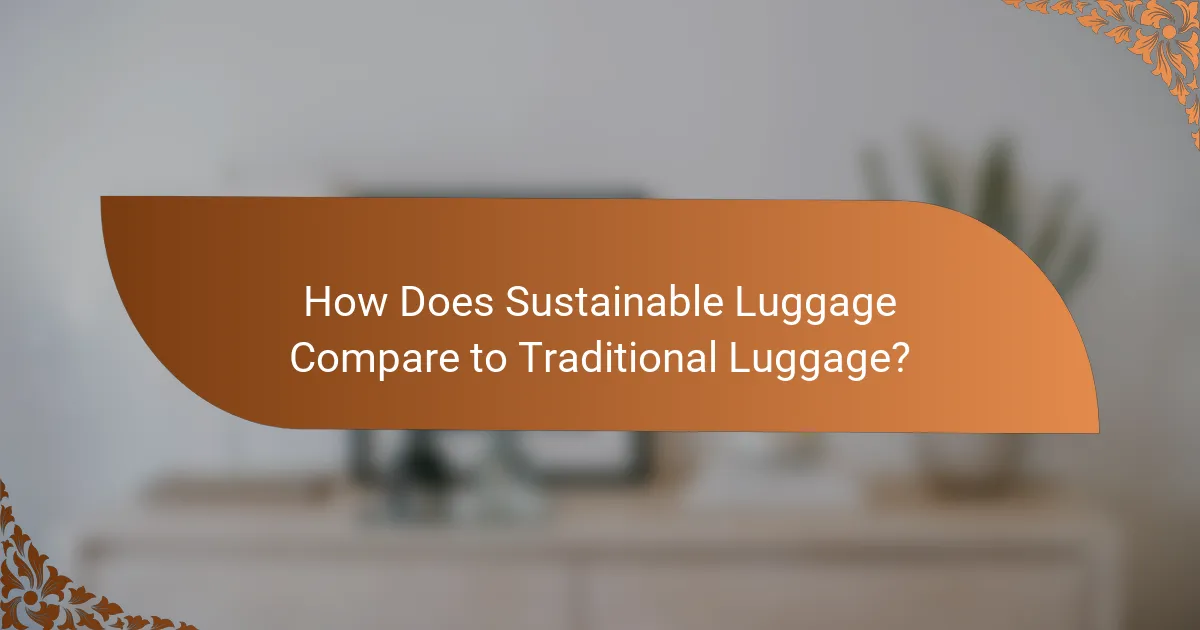Sustainable luggage is crafted with a focus on environmental responsibility, utilizing eco-friendly materials and ethical manufacturing practices. When selecting luggage, it’s essential to consider factors such as durability, recyclability, and the brand’s commitment to sustainability to minimize your travel gear’s ecological footprint.

What Are the Key Features of Sustainable Luggage?
Sustainable luggage is designed with environmental consciousness in mind, incorporating eco-friendly materials and ethical manufacturing practices. Key features include durability, recyclability, and lightweight design, all aimed at reducing the ecological footprint of travel gear.
Eco-friendly materials
Sustainable luggage often utilizes materials such as recycled plastics, organic cotton, and biodegradable fabrics. These materials help minimize the environmental impact associated with traditional luggage production, which typically relies on petroleum-based products.
When selecting luggage, look for certifications like Global Recycle Standard (GRS) or OEKO-TEX, which indicate responsible sourcing and production practices. Brands may also highlight their use of renewable resources, making it easier for consumers to make informed choices.
Durability and longevity
Durability is a crucial feature of sustainable luggage, as longer-lasting products reduce the need for frequent replacements. High-quality construction, reinforced stitching, and robust zippers contribute to the longevity of these items.
Investing in durable luggage can save money over time and lessen waste. Look for warranties that reflect the manufacturer’s confidence in their product’s lifespan, typically ranging from several years to a lifetime guarantee.
Recyclability
Recyclability is an essential aspect of sustainable luggage, as it ensures that the product can be repurposed at the end of its life cycle. Many brands design their luggage with recyclable components, making it easier for consumers to dispose of them responsibly.
Check for recycling programs offered by manufacturers, which may provide incentives for returning old luggage. This practice not only promotes sustainability but also encourages a circular economy in the travel industry.
Lightweight design
A lightweight design is important for sustainable luggage, as it reduces fuel consumption during transportation. Lighter bags can also help travelers avoid excess baggage fees, making them more economical.
When choosing luggage, consider options that balance weight with durability. Many brands offer lightweight materials that do not compromise on strength, often weighing between 2-4 kg for carry-on sizes.
Ethical manufacturing practices
Ethical manufacturing practices ensure that the production of luggage adheres to fair labor standards and environmentally friendly processes. Brands committed to sustainability often provide transparency about their supply chains and labor conditions.
Look for certifications such as Fair Trade or B Corporation status, which indicate a commitment to social responsibility. Supporting companies that prioritize ethical practices contributes to a more sustainable and equitable travel industry.

How to Choose Sustainable Luggage?
Choosing sustainable luggage involves assessing materials, brand practices, size, and warranty options. Prioritize eco-friendly materials and brands committed to sustainability to ensure your luggage has a minimal environmental impact.
Assess material certifications
Start by examining the material certifications of the luggage. Look for certifications such as Global Recycled Standard (GRS) or OEKO-TEX, which indicate that the materials used are sustainably sourced and produced. These certifications help ensure that the luggage is made from recycled or eco-friendly materials.
Additionally, consider the durability of the materials. High-quality, long-lasting materials reduce the need for frequent replacements, further minimizing environmental impact. For instance, luggage made from recycled plastics or organic cotton can be excellent choices.
Evaluate brand sustainability practices
Research the brand’s overall sustainability practices. Brands that prioritize environmental responsibility often disclose their production processes, sourcing methods, and labor practices. Look for companies that engage in fair labor practices and have transparent supply chains.
Check if the brand participates in initiatives like carbon offsetting or has a take-back program for old luggage. This not only reflects their commitment to sustainability but also provides you with options for responsible disposal of your luggage when it reaches the end of its life.
Consider size and capacity
When selecting sustainable luggage, consider the size and capacity that best fits your travel needs. Opt for luggage that meets airline carry-on requirements to avoid extra fees and reduce carbon emissions associated with checked baggage.
Think about your typical travel duration and packing habits. A medium-sized suitcase may suffice for weekend trips, while larger options are better for extended travel. Choosing the right size can help you avoid overpacking, which contributes to unnecessary weight and fuel consumption during flights.
Check warranty and return policies
Review the warranty and return policies before purchasing sustainable luggage. A good warranty indicates the brand’s confidence in their product’s durability and can save you money in the long run if repairs are needed.
Additionally, flexible return policies allow you to assess the luggage’s functionality and comfort. Ensure that the brand offers a reasonable return window, so you can make an informed decision after testing the luggage on your travels.

What Are the Best Brands for Sustainable Luggage?
The best brands for sustainable luggage prioritize eco-friendly materials and ethical manufacturing processes. Notable names include Patagonia, Samsonite Eco, Osprey, and Rimowa, each offering unique features that cater to environmentally conscious travelers.
Patagonia
Patagonia is renowned for its commitment to sustainability, using recycled materials in its luggage products. Their bags are designed for durability, ensuring they last longer and reduce waste over time.
When selecting Patagonia luggage, look for features like water-resistant fabrics and fair trade certification. These elements not only enhance functionality but also reflect the brand’s dedication to ethical practices.
Samsonite Eco
Samsonite Eco focuses on creating luggage from recycled plastics and sustainable materials, making it a strong choice for eco-conscious travelers. Their collections often include lightweight designs that do not compromise on durability.
Consider the Eco range for its innovative features, such as removable and washable linings. This practicality helps maintain the luggage’s appearance while supporting sustainability efforts.
Osprey
Osprey is known for its high-quality outdoor gear, including sustainable luggage options. The brand emphasizes the use of recycled materials and offers a repair program to extend the life of its products.
When choosing Osprey luggage, pay attention to their All Mighty Guarantee, which covers any damage for the lifetime of the product. This commitment to repairability is a significant advantage for environmentally minded consumers.
Rimowa
Rimowa combines luxury with sustainability by using high-quality aluminum and polycarbonate in its luggage. The brand focuses on longevity and craftsmanship, ensuring that their products are built to last.
Rimowa’s commitment to sustainability is evident in its recycling initiatives and the option for customers to send back old luggage for responsible disposal. This approach not only minimizes waste but also promotes a circular economy in the luggage industry.

How Does Sustainable Luggage Compare to Traditional Luggage?
Sustainable luggage typically uses eco-friendly materials and production methods, contrasting with traditional luggage that often relies on non-renewable resources. This difference can lead to a reduced environmental footprint and a more ethical purchasing decision.
Environmental impact
The environmental impact of sustainable luggage is significantly lower than that of traditional options. Sustainable luggage often incorporates recycled materials, biodegradable components, and eco-conscious manufacturing processes, which help minimize waste and pollution.
In contrast, traditional luggage may be made from virgin plastics and other materials that contribute to environmental degradation. Choosing sustainable options can help reduce your carbon footprint and support brands committed to environmental stewardship.
Cost considerations
Sustainable luggage can sometimes be more expensive than traditional luggage due to the higher costs associated with eco-friendly materials and ethical production practices. Prices may range from moderate to high, depending on the brand and features.
However, investing in sustainable luggage can be cost-effective in the long run. These products often last longer and may come with warranties, reducing the need for frequent replacements. Look for brands that offer a balance of quality and price to maximize value.
Performance and durability
Performance and durability are crucial factors when comparing sustainable luggage to traditional options. Many sustainable brands prioritize high-quality materials that withstand wear and tear, ensuring longevity.
While traditional luggage may offer a wide range of styles and features, it is essential to assess the durability of the materials used. Sustainable luggage often meets or exceeds performance standards, making it a reliable choice for frequent travelers. When selecting luggage, consider factors like weight, water resistance, and warranty to ensure you choose a durable option.

What Are the Price Ranges for Sustainable Luggage?
The price of sustainable luggage typically ranges from around $50 to several hundred dollars, depending on the materials, brand, and features. Budget-friendly options can be found for those looking to make eco-conscious choices without breaking the bank, while premium brands may offer high-end designs with advanced sustainability practices.
Budget options
Budget options for sustainable luggage generally fall within the $50 to $150 range. These pieces often utilize recycled materials or eco-friendly manufacturing processes, providing a good balance between affordability and environmental responsibility. Brands like Samsonite and American Tourister offer entry-level sustainable models that are both functional and stylish.
When selecting budget-friendly sustainable luggage, consider durability and warranty policies. A slightly higher upfront cost may lead to a longer lifespan, ultimately saving money over time. Look for features such as water resistance and lightweight designs to enhance usability.
